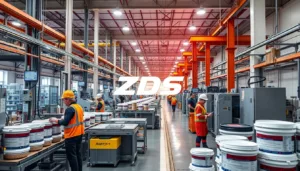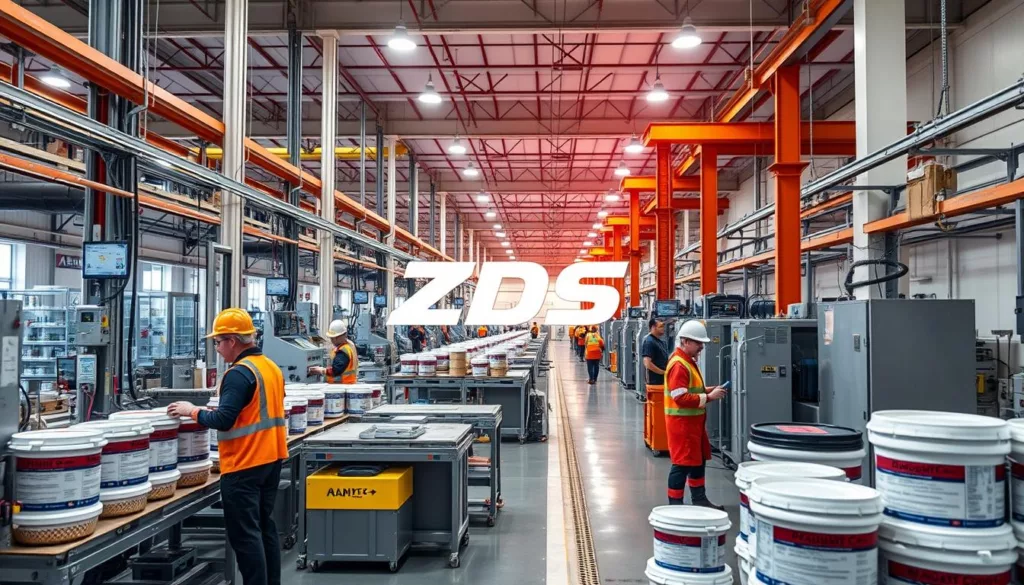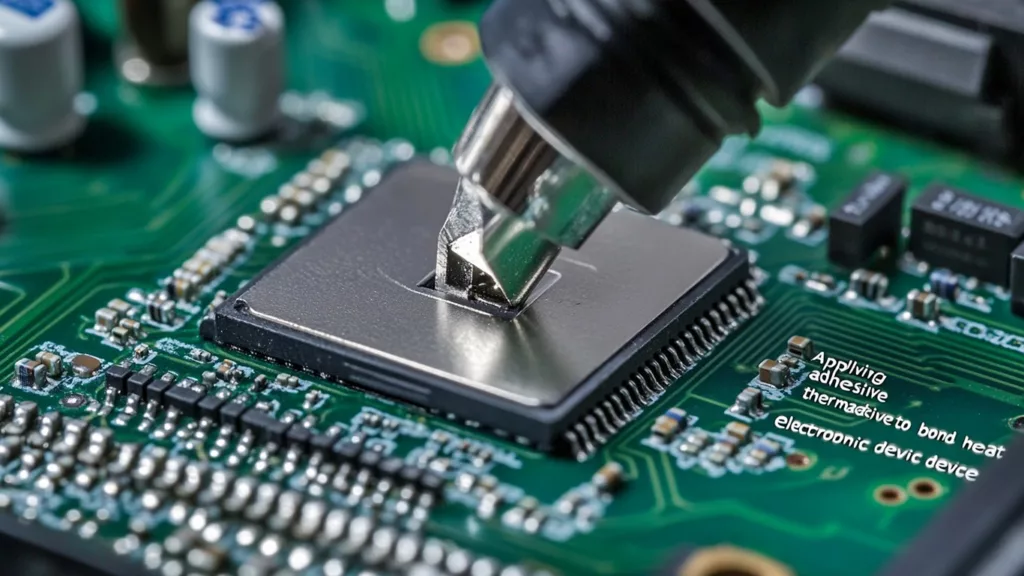In offshore drilling rigs, high-temperature adhesives are crucial. They are essential for keeping equipment safe against extreme heat and the environment. Our dedication to excellence lets us provide top-notch adhesives for oil platforms
This ensures the gear lasts longer and keeps everyone safe in these tough marine surroundings. We focus on strong adhesion to keep things running smoothly and safely.
Key Takeaways
- High-temperature adhesives are critical for offshore drilling operations.
- Heat-resistant adhesives ensure the longevity of equipment in harsh environments.
- Reliable adhesive solutions contribute to operational safety and integrity.
- Our expertise in adhesives for oil platforms enhances performance under extreme conditions.
- Quality craftsmanship drives our innovation in high-temperature adhesive technologies.
Understanding High-Temperature Adhesives
High-temperature adhesives are key for keeping equipment durable in tough conditions like offshore drilling rigs. They can handle extreme heat, ensuring bonds stay strong. This durability is vital for the structure and smooth operation of machinery.
Definition and Importance
These adhesives are made for harsh drilling rig environments. They withstand high heat and pressure. This is important because they keep machinery and structures together. Without them, equipment could fail, causing delays and expensive repairs.
Applications in Offshore Drilling
In offshore drilling, high-temperature adhesives have many uses, including:
- Securing structural components
- Bonding heat exchangers
- Sealing joints and seams
- Repairing critical machinery parts
These adhesives play a big role in drilling success. They help in activities like oil extraction. Companies making high-temperature adhesives for offshore drilling rigs are always working on new solutions.
Key Properties Required
High-temperature adhesives in drilling rigs need certain properties, including:
- Exceptional temperature resistance: Capable of withstanding extreme heat
- Adhesion strength: Maintaining bond integrity under dynamic conditions
- Chemical resistance: Withstanding exposure to harsh chemicals commonly encountered in offshore drilling
- Durability: Ensuring long-lasting performance even in challenging conditions
These qualities are crucial for adhesives to work well, improving success in offshore drilling.
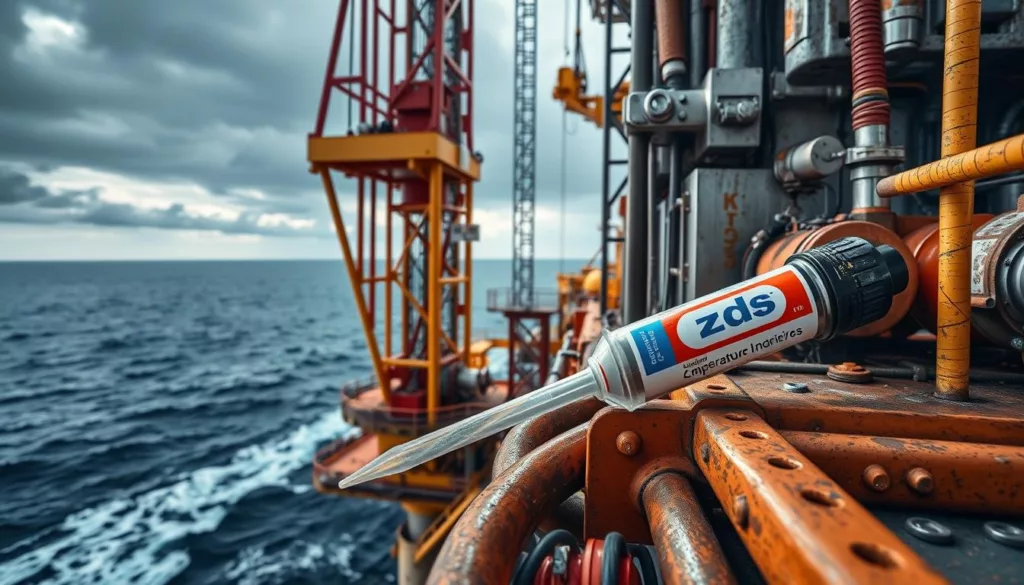
Types of High-Temperature Adhesives
High-temperature adhesives are key in difficult settings like offshore drilling. Knowing the types available ensures they work well and reliably. Let’s look at the main kinds of high-temperature adhesives and what they offer.
Epoxy-Based Adhesives
Epoxy adhesives withstand high temperatures with great strength. They stick to many materials, including metals and plastics. This makes them perfect for tough jobs. Important traits are:
- High thermal stability
- Superior adhesion to diverse substrates
- Excellent chemical resistance
Silicone-Based Adhesives
Silicone-based adhesives handle temperature changes well. These adhesives are great for the sea and when parts move. Their benefits are:
- Broad temperature range
- Good weather resistance
- Low toxicity
Polyimide Adhesives
Polyimide adhesives perform amazingly in super hot or cold places. Places like space and electronics use them a lot. They handle heat and chemicals well. Advantages include:
- Outstanding thermal stability
- Exceptional mechanical properties
- Resistance to solvents and oils
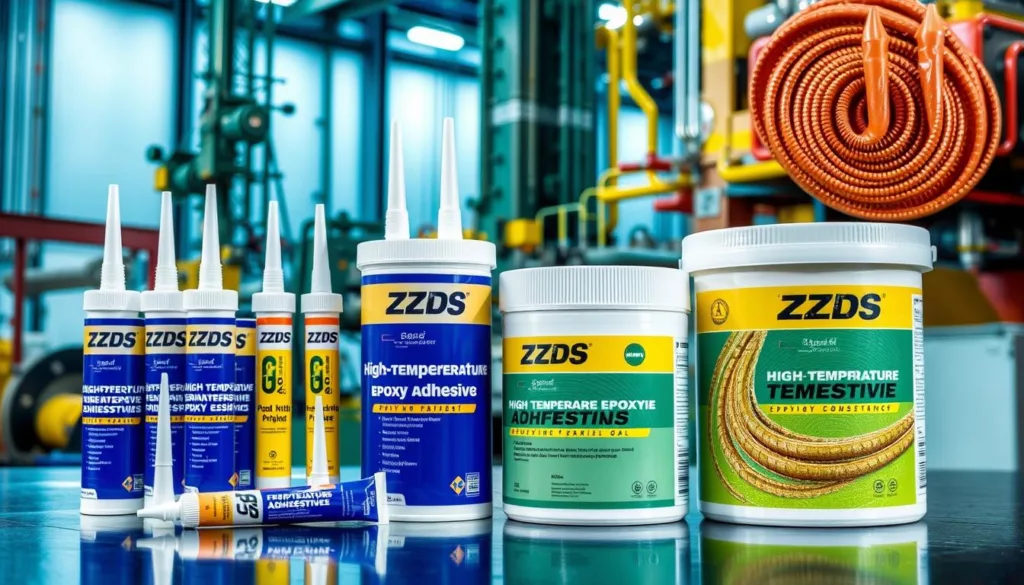
Performance Characteristics in Harsh Environments
In offshore drilling, the success of high-temperature adhesives depends on certain key features. These features make sure they are reliable and durable in tough conditions. Here, environmental and operational challenges can greatly affect their performance.
Temperature Resistance
High-temperature adhesives need to hold up against different levels of heat. They must keep their stickiness even when it gets really hot. This helps them work well in the hot conditions found in offshore drilling.
Being able to handle big changes in temperature without breaking down is crucial. This prevents equipment from failing and keeps things running smoothly.
Chemical Resistance
In offshore drilling, materials meet many chemicals, like drilling fluids and corrosive agents. So, we need adhesives that can handle these tough chemicals. Adhesives that don’t react much to chemicals ensure they last longer and keep structures stable.
Adhesion Strength
The adhesive’s ability to stick things together well is really important. A strong bond means materials stay together, even when shaken or under lots of pressure. Picking the best high-temperature adhesives for offshore rigs means checking how well they stick.
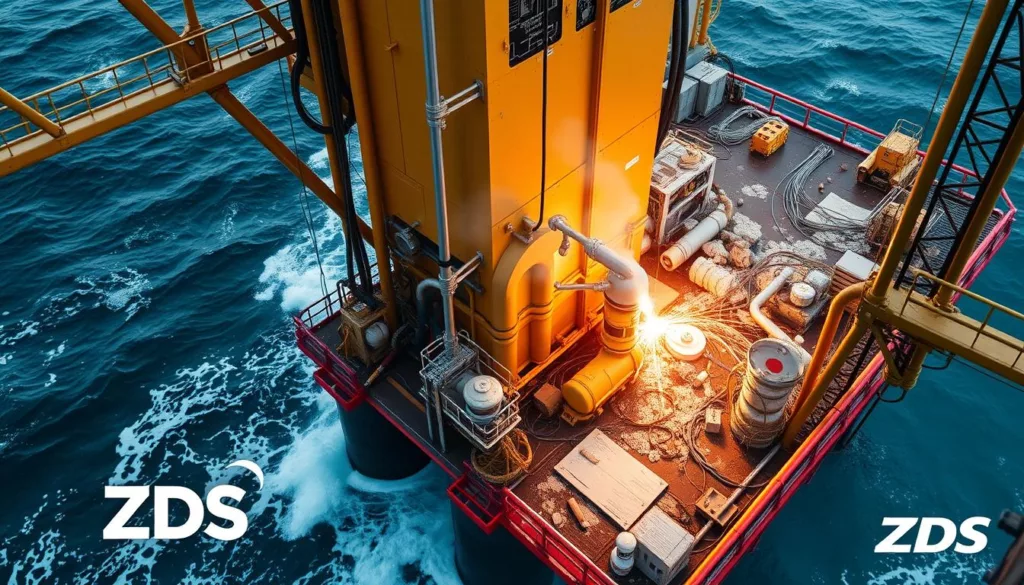
| Performance Characteristic | Importance | Recommended Adhesive Solutions |
|---|---|---|
| Temperature Resistance | Prevents adhesive failure due to extreme heat | Silicone-Based Adhesives |
| Chemical Resistance | Ensures longevity against corrosive substances | Epoxy-Based Adhesives |
| Adhesion Strength | Maintains bonds under mechanical stress | Polyimide Adhesives |
Selection Criteria for Offshore Applications
Choosing the right high-temperature adhesives for oil platforms demands deep knowledge. These adhesives must resist extreme conditions and stay reliable. Here are key points to consider when picking adhesives for drilling rig settings.
Environmental Factors
Adhesives for oil platforms need exceptional resistance to harsh weather. They must handle saltwater, humidity changes, and extreme temperatures. Choosing adhesives made for drilling environments ensures they perform well over time.
Weight Considerations
The weight of adhesives is crucial offshore, as extra weight can weaken the structure. Light, strong options are vital. They stick well without weighing down the platform. Producers must focus on balance: strong yet lightweight.
Regulatory Compliance
Adhesives in oil platforms have to meet tough standards. They should follow safety and environmental rules to run smoothly. Picking adhesives with proper certifications means safety and efficacy. For more information on adhesive options, visit this resource.
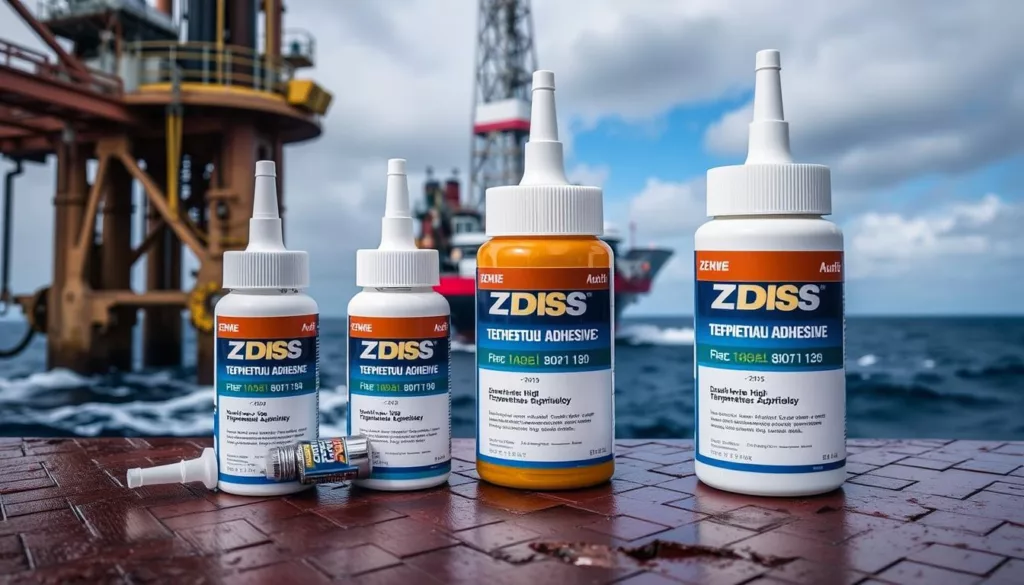
| Criteria | Considerations |
|---|---|
| Environmental Factors | Resistance to saltwater, humidity, and temperature extremes |
| Weight Considerations | Lightweight yet high-strength options |
| Regulatory Compliance | Adherence to safety and environmental regulations |
The Manufacturing Process
Making high-temperature adhesives for offshore drilling rigs is complex. The process ensures they’re tough and reliable in rough sea conditions. We focus on picking the best raw materials, using advanced ways to put them together, and checking their quality. These steps make sure the adhesives work well for offshore drilling.
Raw Material Selection
It’s important to choose the right materials. They need to handle extreme heat and chemicals. We mainly use:
- Epoxy resins for their strong adhesion properties
- Silicone compounds that provide flexibility and temperature resistance
- Polyimides known for their high thermal stability
Polymerization Techniques
Turning raw materials into usable glue involves polymerization. The way we do this affects the adhesive’s qualities:
- Thermal Polymerization: Uses heat to start the process, making it perfect for high-heat situations.
- Chemical Polymerization: Uses special chemicals to control how fast the reaction happens, making the glue stronger under pressure.
- UV Curing: Uses UV light to quickly set the glue, great for some special uses.
Quality Control Measures
Quality always comes first. We test thoroughly during production:
- Viscosity testing to make sure it spreads right
- Adhesion strength analysis to check it sticks well
- Thermal cycling tests to see how it does in extreme temperatures
We take steps at every stage to ensure our adhesives can handle tough conditions. By focusing on everything from picking materials to checking quality, we ensure our products perform exceptionally well and are reliable.
Leading Brands in High-Temperature Adhesives
In the race for the best high-temperature adhesives, some brands stand out. They create products for tough drilling rig conditions. These companies make sure their adhesives work well offshore, facing both reliability and tough tests.
3M
3M is known for breaking new ground in the adhesive market. Their products can take on the harsh conditions of offshore drilling. They focus on making adhesives that stick well, last long, and resist various chemicals.
Henkel
Henkel is a reliable brand for tough drilling adhesives. They aim to make products that perform well and are safe. Their lineup meets different needs, like bonding and sealing.
Loctite
Loctite is part of Henkel and is praised for quality adhesives. Their products are made to work great and be easy to use in drilling sites. Loctite’s adhesives are strong and can handle high temperatures, which makes them popular.
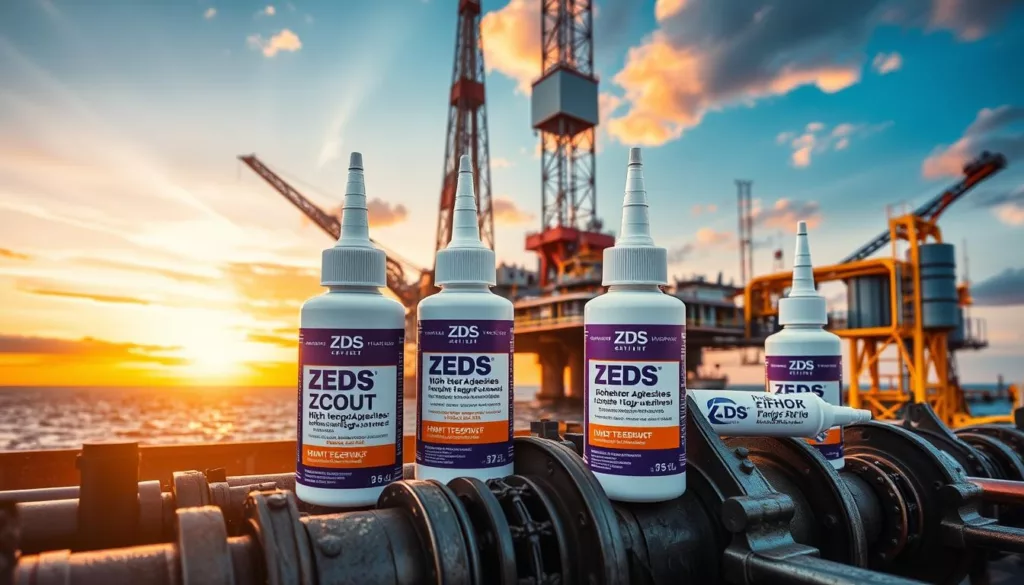
Case Studies: Successful Applications
Looking at real-world uses of high-temperature adhesives for offshore drilling rigs gives us important insights. We see their effectiveness and reliability under tough conditions. It’s key to learn from both the wins and the fails to make adhesive tech better in the oil and gas world.
Real-World Offshore Projects
Many big offshore drilling projects have used high-temperature adhesives well. These adhesives helped strengthen structures and lower risks. They’ve been key for tasks such as:
- Sealing joints in drilling risers.
- Bonding components in subsea installations.
- Reinforcing equipment subjected to high pressure and temperature changes.
Lessons Learned from Failures
While many projects succeeded, some faced problems. This shows how crucial picking the right materials and application methods is. Common problems faced included:
- Inadequate adhesion due to surface contamination.
- Failure to meet thermal cycling requirements.
- Poor compatibility with marine conditions, leading to damage.
Overcoming these challenges led to better adhesives for high-temperature jobs. This ensures future offshore drilling rigs use more reliable and sturdy adhesives.
Innovations in Adhesive Technologies
Recently, there have been big steps forward in adhesive tech for offshore drilling. New adhesives are being made with better features such as:
- Improved thermal resistance.
- Higher adhesion strength under changing conditions.
- Better resilience against chemicals from drilling fluids.
High-temperature adhesives for offshore drilling rigs are improving. This leads to safer and more efficient industry operations. These advances ensure projects are more likely to succeed.
Future Trends in High-Temperature Adhesives
The world of high-temperature adhesives is changing quickly. This is especially true for offshore drilling rigs. New discoveries in material science will change how we use heat-resistant adhesives. They’ll perform better and be used in more ways.
Advancements in Material Science
There’s a lot of new work being done to make high-temperature adhesives better. These new adhesives can handle tough environments without losing their stickiness. Scientists are working with nano-materials and new kinds of polymers. These materials can handle more heat and chemicals. That means the adhesives last longer and are more reliable. Companies like ZDSpoxy are leading this charge. They’re making adhesives that can be customized for different industries.
Increasing Demand in the Oil and Gas Sector
The oil and gas industry needs more high-temperature adhesives than ever. This is because drilling projects are becoming more complex. So, there’s a bigger demand for adhesives that can handle extreme heat and pressure. Companies are investing in new tech to meet this challenge. They’re also looking for ways to make these adhesives more eco-friendly. This is important because it helps the environment without sacrificing quality.
| Feature | Traditional Adhesives | Advanced High-Temperature Adhesives |
|---|---|---|
| Temperature Resistance | Up to 150°C | Up to 300°C |
| Chemical Resistance | Limited | High resistance to solvents and harsh chemicals |
| Durability | Shorter lifespan | Extended lifespan and performance stability |
| Customization | Standard formulations | Customizable for specific applications |
The future looks promising for high-temperature adhesives in offshore drilling. Innovations keep meeting the industry’s growing needs.
Key Considerations for Use on Drilling Rigs
Using high-temp adhesives on oil platforms needs careful thought. They must meet the challenges of tough conditions. It’s key to know how to apply them. The right application ensures strong bonds and reliability. Mix and apply the adhesive by following the guidelines. Make sure the surface is ready and the conditions are right before starting.
Application Techniques
Different methods like spraying, brushing, or using a dispenser are used for adhesives on rigs. Try a test application first to see how well it sticks. Training technicians regularly ensures high-quality application. This keeps the adhesive working well in harsh drilling environments.
Maintenance and Inspection
Maintenance and checks are crucial for the adhesive’s durability. Set up a routine for inspections to spot wear or failure early. Pay extra attention to areas with high heat or chemical exposure. This can reduce risks and make the bond last longer.
Safety Protocols
High safety standards are a must when using adhesives offshore. Workers need the right safety gear and training in chemical safety. Following these rules keeps everyone safe and makes operations run smoothly. For more on safe, high-quality adhesives, see our selection at quality adhesive options.
FAQ
What are high-temperature adhesives and why are they important for offshore drilling rigs?
High-temperature adhesives are special glues that can handle extreme heat and tough conditions found in offshore drilling. They are crucial for keeping equipment safe and reliable, protecting both people and assets.
What types of high-temperature adhesives are suitable for marine applications?
For marine use, epoxy, silicone, and polyimide adhesives are commonly chosen. Each has advantages depending on the drilling environment’s specific needs.
How do I select the appropriate adhesive for my project’s needs?
Choosing the right adhesive means looking at environmental factors, weight, and industry rules. Specialized adhesives can handle the tough conditions of drilling rigs.
What performance characteristics should high-temperature adhesives possess?
They need to stick very well, resist high temperatures, and hold up against chemicals. This ensures they work well offshore.
What are some leading brands that produce high-temperature adhesives for offshore applications?
3M, Henkel, and Loctite are top names. They make quality adhesives for drilling rig challenges.
Can high-temperature adhesives be used for repair and maintenance on drilling rigs?
Yes, they are great for fixing and upkeeping drilling rigs. They bond strongly, even under lots of stress, and help equipment last longer.
What advances in material science can we expect for future high-temperature adhesives?
Future improvements will boost performance, make them withstand heat better, and meet the growing oil and gas industry needs.
How should high-temperature adhesives be applied on drilling rigs?
Apply them by cleaning surfaces first, following the curing instructions, and observing safety measures for the best results.



